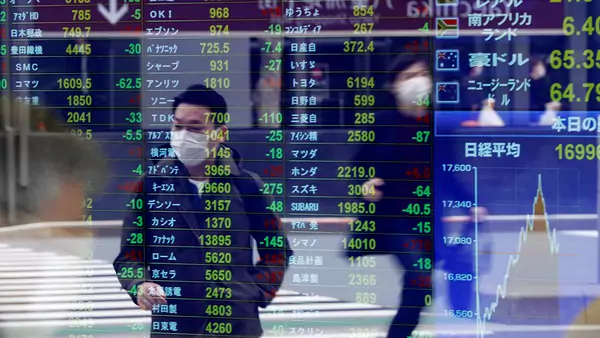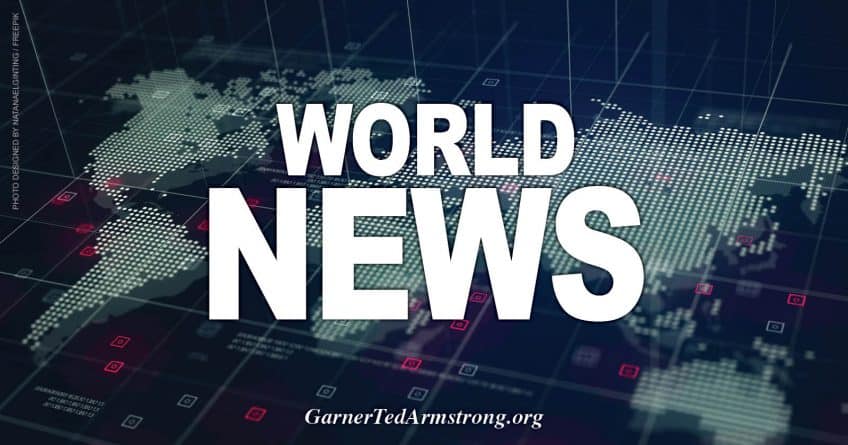The coronavirus pandemic is slowing global commerce to a crawl, but many of the world’s largest economies are taking extraordinary actions to propel them through the crisis.

A pedestrian wearing a protective face mask amid the the coronavirus (COVID-19) outbreak is reflected on a screen displaying stock prices outside a brokerage in Tokyo, Japan, on March 17, 2020.
The coronavirus is throttling the global economy. In a matter of weeks, the highly contagious disease has pushed the world to the brink of a recession more severe than the 2008 financial crisis. The depth and duration of the downturn will depend on many factors, including the behavior of the virus itself, public health responses, and economic interventions.
Given the extraordinary nature of the pandemic-induced crisis, fiscal and monetary policymakers are working without a playbook. Many, however, are moving forward with stunning bailouts that could collectively top $10 trillion.
How bad will the recession be?
Readings in April suggested the global economy was sailing into a colossal storm. “We anticipate the worst economic fallout since the Great Depression,” said Kristalina Georgieva, managing director of the International Monetary Fund (IMF). Meanwhile, the Organization for Economic Cooperation and Development said its indicators produced the strongest warning on record that most major economies had entered a “sharp slowdown.” The World Trade Organization, for its part, forecast that nearly all regions of the world would suffer double-digit declines in trade this year, with North American and Asian exporters hit hardest.
Many governments have effectively frozen social and economic activity in all or parts of their countries to contain the outbreak, shuttering nonessential businesses and ordering residents to stay at home for weeks or months. Billions of people worldwide remain under some type of lockdown. Major industries, especially airlines and other travel-related sectors, are on the brink of bankruptcy. The hope is that economies can power down without causing extreme disruptions, such as widespread business failures or joblessness, and then quickly get back up to speed after the pandemic abates.
Just how quickly governments should unshackle their economies is a matter of debate. Some governments in Asia and Europe that feel they’ve contained the virus have begun to slowly reopen their economies. Similarly, more than a dozen U.S. states are loosening restrictions, and President Trump did not renew federal social-distancing guidelines, which expired on April 30. But new outbreaks have already caused some countries to reimpose restraints.
For now, some economists hope for a strong global rebound in the third quarter, mirroring the recoveries in Asia after the Severe Acute Respiratory Syndrome (SARS) outbreak of 2003. However, others warn that the pandemic could be far more economically destructive than any past outbreak, and caution that a recovery could take much longer.
In the meantime, many world powers are moving mountains to prop up their economies during the coronavirus downturn.
China
The world’s second-largest economy was stirring back to life in April after suffering a withering blow from the coronavirus, which originated in the city of Wuhan in Hubei Province in late 2019. Several weeks of government-imposed lockdowns on dozens of cities led to steep declines in factory output, retail sales, construction, and other economic activity. Overall, gross domestic product (GDP) dipped almost 7 percent in the first quarter, China’s first economic contraction in more than forty years.
China’s leadership seems less inclined to spearhead a global economic recovery this time than it did following the 2008 financial crisis, when it spent liberally on a stimulus package of more than a half trillion dollars. In the years since, China has roughly doubled its government debt—to about 60 percent of gross domestic product (GDP)—and many analysts think it cannot afford to spend so aggressively again.
So far, China’s central bank has taken relatively modest actions, reducing reserve requirements for banks, which will allow them to loan an additional $80 billion to struggling businesses, and indicating that it will cut interest rates in the months ahead. “The normal monetary policy should be kept as long as possible,” wrote central bank chief Yi Gang in late April. “The impact of the pandemic is temporary. China’s economy has strong resilience and great potential, while the fundamentals for high-quality development won’t change.”
Analysts say a major sign to watch will be Beijing’s announcement of its annual growth target, which was postponed from March to May because of the virus. An ambitious goal of around 6 percent could signal that a hefty stimulus package is coming, while a more modest number, closer to 3 percent, would likely mean a continuation of the status quo. There is also a possibility that China may forgo setting a target for this year. To hit its long-held goal of doubling GDP between 2010 and 2020, China would have to grow at least 5.6 percent this year, a pace few economists think is possible.
Germany
The German economy is expected to shrink for the first time since 2009, anywhere from 3 to 10 percent this year. The government itself forecasted a contraction of just over 6 percent, which would be the economy’s worst performance in decades. In March, nearly a half million German companies applied to have their employees join a short-term government work program intended to prevent mass layoffs.
To counter the economic fallout from the coronavirus, Berlin is taking bold actions, abandoning its steadfast commitment to balanced budgets, known as schwarze Null or “black zero.” It is allocating at least 350 billion euros—or about 10 percent of its GDP—to prop up the eurozone’s largest economy. Funds will be spent to bail out struggling businesses, including by making unlimited loans and potentially taking equity stakes.
“We’re doing whatever is necessary,” said Chancellor Angela Merkel, who also led the country through the 2008 crisis. “And we won’t be asking every day what it means for our deficit.” Officials note that Germany is poised to spend aggressively because the government has kept its finances in check in recent years, reducing its debt-to-GDP ratio from more than 80 percent in 2010 to below 60 percent today.
After moving swiftly to control the outbreak within its borders, Germany announced in mid-April that it would slowly reopen its economy. However, Merkel cautioned state leaders—Germany has a federal system—to lift restrictions with great care.
Japan
Economists predict that Japan’s export-driven economy will shrink by around 3 percent this year, which would be its worst performance since 2008. The deep impact from the pandemic comes on the heels of an economic slowdown from a sales tax hike last fall. The virus has also forced the government to postpone the Summer Olympics until next year.
Like some of its peers in the West, the Japanese government has responded with a massive relief package, worth nearly $1 trillion, to help the country through one of its most challenging periods in recent memory. The headline figure is equal to about 20 percent of Japan’s GDP, but analysts say the actual spending impact will be much smaller.
“It is no exaggeration to say that Japan’s economy, and the world economy, is facing the biggest crisis since [World War II] right now. We will protect employment and life at all costs,” said Prime Minister Shinzo Abe. Bailout measures include cash payments to citizens and small and midsize businesses, interest-free loans, delayed tax payments, and travel and tourism coupons.
Japan’s central bank announced in late April that it was prepared to buy an unlimited amount of government debt and to double its purchases of corporate debt. However, some critics say the Bank of Japan has limited options after having kept interest rates next to zero for years.
United Kingdom
The pandemic is paralyzing the British economy just as its leaders are negotiating a post-Brexit relationship with the European Union. Prior to the outbreak, there were already concerns about a recession from a so-called hard Brexit. Economists say that the coronavirus pandemic could take a 5 to 10 percent slice out of the economy in 2020.
The government is prepared to make interventions that would be “unprecedented in the history of the British state” to support the economy, finance minister Rishi Sunak said in early March. Among its emergency measures, the Treasury has pledged to pay 80 percent of workers’ salaries for several months to keep companies from resorting to huge layoffs; offered to reimburse self-employed workers for lost wages; deferred tax payments; increased unemployment benefits; established a loan program for small and midsize companies; and provided rescue aid to charities.
The Bank of England has dropped its benchmark interest rate to 0.5 percent, a record low, and loosened capital requirements for banks. In an extraordinary move in early April, the central bank agreed to directly finance the government’s spending during the crisis, freeing it from having to issue debt in the bond market. All told, the rescue efforts could see Britain spend upward of 400 billion pounds, or about 15 percent of GDP.
United States
In a sign of the staggering toll the virus was taking on the U.S. economy, more than thirty million Americans—about one in six U.S. workers—have filed for unemployment since mid-March. Before this crisis, the highest number of filings in a single week was 695,000, in 1982. Economic output plunged by nearly 5 percent in the first three months of 2020, the steepest dive since 2008. Most analysts expect the damage to be far worse in the second quarter, with some suggesting that the unemployment rate could reach as high as 40 percent, significantly higher than its peak of 25 percent during the Great Depression.
While Washington has been criticized for mismanaging the public health response to the pandemic, it’s also been credited with moving decisively to stabilize financial markets. In March, the Federal Reserve indicated that it will do anything within its power to support the economy and provide liquidity. Among the Fed’s historic actions have been: cutting interest rates close to zero, reducing bank reserve requirements to zero, rapidly purchasing nearly $2 trillion in Treasury bonds and mortgage-backed securities, buying corporate and municipal debt, and extending emergency credit to nonbanks.
Meanwhile, on the fiscal side, lawmakers passed a $2 trillion stimulus package in March that some analysts have characterized as a bridge loan to get the U.S. economy through the crisis. It includes direct payments of up to $1200 to individuals, hundreds of billions of dollars in loans and grants to businesses, increases to unemployment benefits, and support for hospitals and health-care providers. “In effect, this is a wartime level of investment into our nation,” said Senate Majority Leader Mitch McConnell. A month later, Congress signed off on a second bailout package, this one totaling close to a half billion dollars and aimed at providing relief to small businesses and more aid to hospitals.
Multilateral Institutions
European Union. Eurozone finance ministers agreed to a 500-billion-euro package to provide emergency lending and other assistance to member countries, businesses, and workers. Christine Lagarde, president of the European Central Bank (ECB), has promised there will be “no limits” on the ECB’s defense of the eurozone. The bank is set to buy up to 750 billion euros in additional bonds this year to help its members amid the downturn.
International Monetary Fund. The IMF has set aside $100 billion to lend to member countries that are facing acute financial crises because of the coronavirus, with preference given to emerging economies. By early April, more than ninety countries had requested bailouts.
World Bank Group. President David Malpass said the bank was committing more than $150 billion to counter the pandemic’s effects. More than two dozen virus-related loan requests have been fast-tracked, with many more in the pipeline. Thus far, India has received the largest loan at $1 billion.
Source: https://www.cfr.org/backgrounder/coronavirus-how-are-countries-responding-economic-crisis
[Disclaimer]






